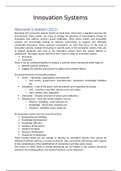Innovation Systems
Wieczorek & Hekkert (2012)
Nowadays the economies depend heavily on fossil fuels, which have a negative cause for the
environment. Policy makers are trying to change the direction of technological change by
innovation that address society’s grand challenges. These policy makers and innovation
scholars are increasingly looking at systemic instruments to support and stimulate
sustainable innovation. These systemic instruments are tools that focus on the level of
innovation systems instead of focusing on specific parts of the innovation system, they aim
to address problems that arise at the innovation system level, like system failures or
weaknesses. This paper argues that there are 2 ways to study an innovation system:
1. Structural
2. Functional
These 2 can be combined together to analyse a systemic policy framework which helps to:
1. Identify systemic problems
2. Suggest the systemic instruments to address the problem/failure
Structural elements of innovation systems
Actors – individuals, organisations and networks
o Civil society, government, manufacturers, companies, knowledge institutes
etc.
Institutions – rules of the game, how innovations are interpreted by society
o Soft – unwritten rules like cultural norms and values
o Hard- written rules, legislation
Interaction – dynamic structure of actors and institutions
Infrastructure – How the country/region is set up
o Physical – Buildings, roads harbours etc.
o Knowledge – Know-how, expertise etc.
o Financial – Subsidies, loans, banks etc.
An innovation system also has several functions
1. Entrepreneurial Activities
2. Knowledge Development
3. Knowledge Diffusion
4. Guidance of the Search
5. Market Formation
6. Resource Mobilisation
7. Counteract to Resistance
These function alone are not enough to develop an innovation system, they cannot be
influenced without altering a structural element. Also uncertainty will emerge with regards
to the completeness of the identified list of mechanisms and thus policy issues.
The reason of either weak or strong functioning can be related to the systems structural
elements. By creating policies, the system functions can be improved.
,An innovation system has systemic problems, these problems occur because of various
reasons. It can be because of systemic failures or because an actor is absent or too present.
A few examples are:
Actor and market side – Poor articulated demand, poor market control by incubants
Network side – Poor connectivity or guidance to future market
Institutions – Legislative failures, educational failures
Infrastructural – Provision and investment problems
Sometimes a lock-in occurs, this is a vicious circle of problems that affect different functions.
Another kind of failure is a transition failure.
A system does not function well when there is a problem with:
The presence and capabilities of the actors
o Presence related – certain actors may be absent
o Capacity related – Lack of competence, learning abilities, use of resources,
identifying and articulating needs.
The presence and capabilities of the institutions
o Presence related – Specific institutions might be absent
o Capacity related – Strict institutions may lead to favouring incumbents, weak
institutions may hinder innovations
The presence and capabilities of the interactions
o Presence related – Interactions are missing because of distance between
actors, different assumptions/objectives/capacities or lack of trust
o Capacity related – Some actors may be weakly guided, fail to provide others
with information because:
Myopia – favouring incumbents, blocking external sources
Over or strong involvement of incumbents
Dependence on dominating partners due to specificity
Weak interaction can occur because of poor connectivity of actors which
hinders innovation and learning, this is a complimentary problem.
The presence and quality of the infrastructure
o Presence related – Specific type of infrastructure is missing
, o Capacity related – Infrastructure is inadequate or malfunctioning
By looking whether the elements are missing/weak or too strong, you can analyse why the
system is not working properly.
Not all actors or institutions have to be present to prevent systemic failures, because the
presence of some actors can actually hinder the system. An overview of all elements and
problems can help to analyse the system thoroughly, and to stimulate combinations of
elements and so create the best chances for an innovation to diffuse successfully.
Blocking Mechanisms and system failures
Lack of actors and resources in middle of the chain
o Presence of actor and infrastructural problem
Weak advocacy problem
o Interaction presence problem
Lack of standards
o Institutional problem
Lack of standard software
o Infrastructural problem
Lack of competence/poor demand
o Actors capabilities problem
Inadequate knowledge
o Infrastructural quality problem
Systemic instruments can be used for different purposes:
Building and organizing innovation systems
o Ensuring presence of relevant actors, institutions, interactions and
infrastructure
o Can be more specific depending on problem
Provide platform for learning and experimenting
o Way to address problems with actors’ capabilities to learn new technologies




